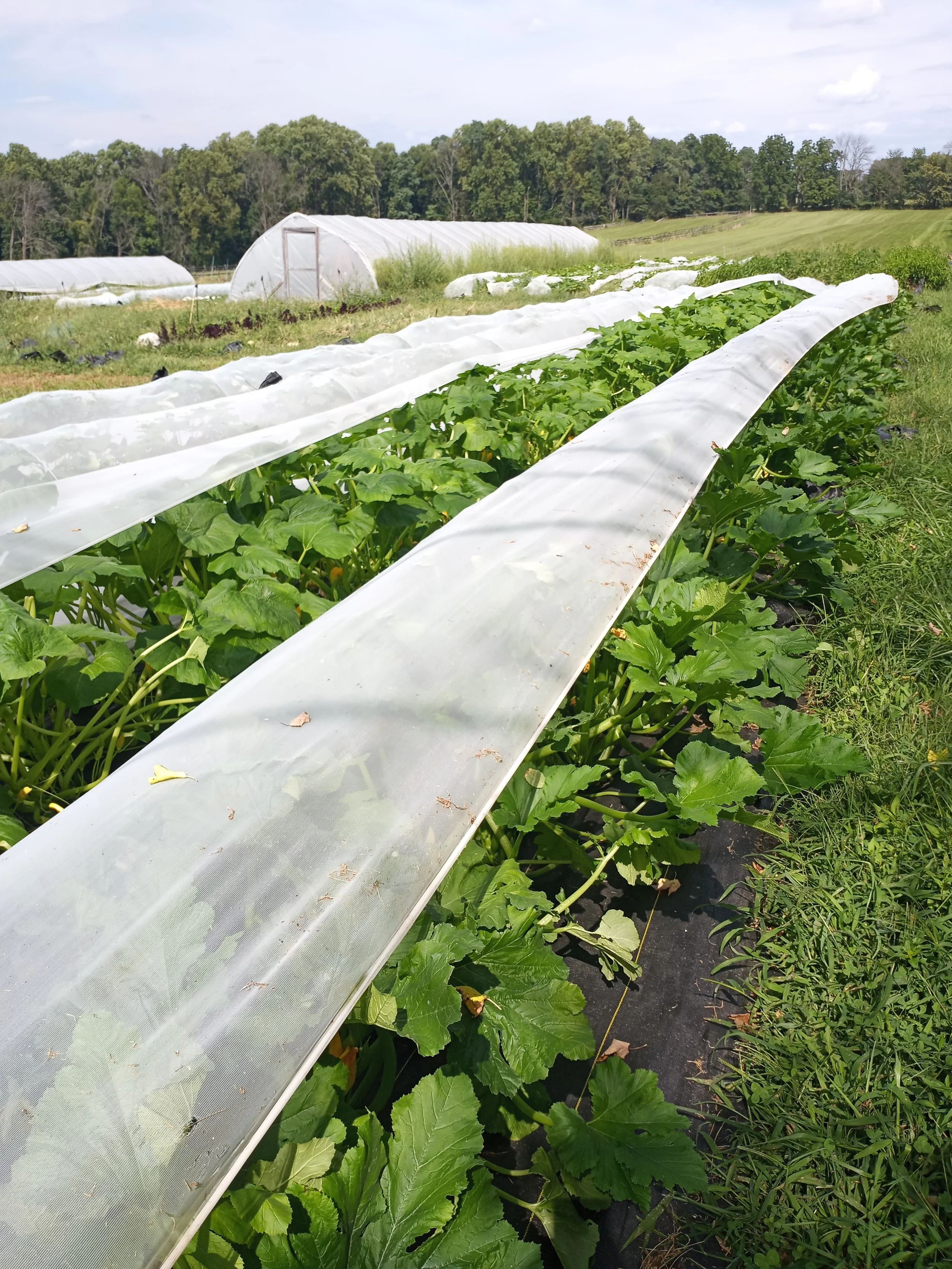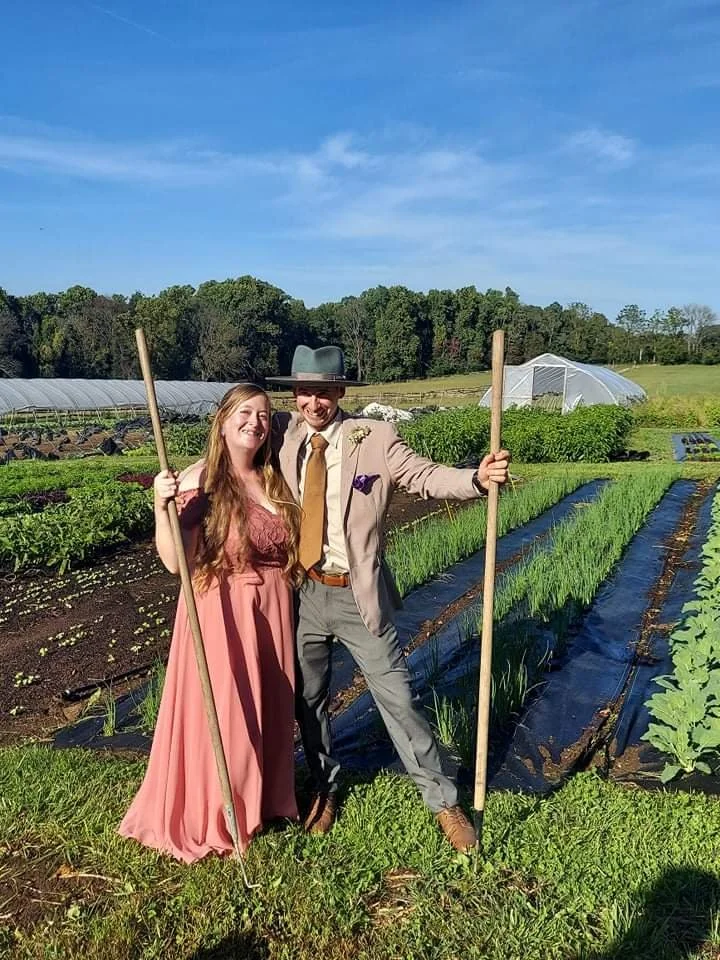Farm Hard or Hardly Farm
Above is a satellite view of the farm from what looks like last spring. If you looked now you would see tarps beyond those dueling tunnels preparing the soil for our additional thirty 100 foot beds. You may notice, these aren’t long continuous plots that get turned over with a plow and disced smooth with a tractor, easily driven around on to spread chemical sprays; no no. These are permanently raised beds to which we hand deliver compost with a wheel barrow for fertility. Using a walk behind tractor we create these beds to help with drainage and to define our growing space to minimize the area of disturbance. Utilizing the slight slope, we design our gardens against the hill too help slow, spread, and sink the water as part of our implementation of Permaculture design principles. The standardized bed sizes help us to plan and reuse materials all over the farm year after year. The breaks in the plots help to minimize any potential erosion and allow us to move through the plots with our garden cart. The farm is mowed with a push mower, although I may play around with using a scythe to make hay to use as mulch to get away from plastic weed barriers… I’ll keep you posted on that.
You probably already know from keeping up with us but you will see in the above image all of our season extension cover, which is also changed out in summer for pest protection on many crops. These are used year after year and held down by several hundred sand bags (some filled with rocks picked from the gardens). The covers are floating on steel hoops that we place every 2 steps for season extension sometimes 4 steps for the insect netting.
Laurel Valley soil of Avondale supplies us our 90-120 cubic yards of compost. That is 3 or 4 of these dump trucks over the course of the season. 40 foot beds get 2 wheel barrows twice a season and 100 foot beds get 5 wheel barrows naturally. I’m pretty happy with the fact I can move 50 wheel barrows a day hoping for 75 record this fall/winter before laying gardens to rest under tarp to stay dry and warm sooner.
Large scale farms have tractor implements that lay down a thin plastic to help with weed suppression. Some of them are bio-degradable but many just get pulled up and thrown away every season. We use this woven ground cover year after year and have a love hate relationship. This method is an easy solution to weeds, not too difficult to lay down held with ground staples placed every 2 or 3 steps. My concern is that we may be spreading disease as the holes are permanent and lend themselves to being used for the same crop. For this reason, and of course our goal of reducing reliance on plastics, I am hoping to utilize farm made straw from scything as I’ve mentioned above. This practice would help to feed the soil biology, protect the biology and soil from the sun, hold in moisture, and be produced on the property. If I can find the time to do this (and get my scythe in order) I think this could be a big level up towards our sustainability.
This insect netting is great at keeping pests out, until the plants outgrow it. We are considering investing in wider netting that could cover more beds or be placed over larger hoops allowing for more time under cover, but most crops still eventually will outgrow the hoops or need to be pollinated. This has been trouble especially for the bean beetles. It doesn’t take but a week after uncovering before these invasive pests can overcome your bean crop to a population that is ready to move to your next succession. This season as our sprouting broccoli has grown to touch the insect netting, the harloquin bugs have found out they can suck the sap from them right through the netting. My other concern with this practice is the same as the ground cover, are we spreading disease? Perhaps getting larger cover and higher hoops could help this potential issue allowing for more air flow as well as staying off of the plants themselves.
Some crops you find in the grocery store and I wonder how is a farmer making money on this if the grocer is selling it this cheap? Well, they have tractors for much of the work we do by hand. All of our carrots, potatoes, beans, peas, sweet potatoes are harvested by hand not dug up by a tractor and picked up with a conveyor belt. Even our spinach is picked leaf by leaf to ensure our second pick is a fresh full leaf, not a half a leaf that grew up after being previously cut. Not only are these crops dug and picked by hand, we put them in the ground by hand. If it went into a trench and got hilled like potatoes, we did that by hand. A new gadget a lot of farmers on our scale are using is like our direct seeder, but it plants plants that were sown into paper cups that are on a chain and you pull the implement through the soil and it drops the chain of plants. We prefer to have a direct relationship from sowing the seed in the trays to planting them, allowing us to ensure they are pest free and with quality roots. We are also unsure of putting this paper and the glue holding it together into our soil regularly.
As most of you know, we double wash all of our bagged greens. We find that getting these tender crops right into some cold water helps not only to clean them, but to lock in the cripness of that early morning pick. After transferring the harvest into a second batch of clean water we hand spin these crops dry with a 5 gallon salad spinner. We bag these up and get them into the walk in cooler as quickly as we can. These crops and bunching greens are harvested as fresh for market as possible and are always hydro-cooled for optimal freshness and storage potential. If you are a gardener, we highly recommend getting your leafy crops into cold water as soon as possible after harvest.
No, they should not be laying on the ground like that. Picking them back up is a team effort.
I’m sure many of you who regular the markets and read Sammy’s newsletter have noticed this fall hasn’t been particularly bursting with plenty. With the drought, and the onslaught of tomato harvest, this summer was a tough time for us in the fields. I had a lot of trouble getting our greens to germinate in the gardens, I suspect from the hot dry soil. I need to be better about getting shade cloth and water on as soon as I get these seeds in during the summer. Whole crops of lettuce bolted to seed, even under shade cloth. Most recently, after great germination, a few rainy cloudy days encouraged the worms to either eat, or greatly disturb baby leaf lettuce to the point of near 50% loss. With these challenges come lessons in timing, spacing, patience. Sometimes, when it seems like everything is a lesson of rewriting the problem on a chalkboard over and over it’s hard to keep your head in the game. Thankfully we have a great community of folks who regular the market, and a great market manager helping to get new people to find the markets. We are always encouraged by your appreciation and kind words and look forward to dialing in our skills and knowledge to provide you all with the best crops for as long as we can and at the necessary volume to sustain the communities appetite.
As you may have heard, we are moving! After years of commuting from West Chester we are moving to Glenmoore just 4 minutes from the farm. We are looking forward to being able take better care of the gardens, ourselves, and our old dog. As we look back on this season and ahead to next season, we will be thinking a lot about how we can improve and better prioritize our time to keep up with the demands of the fields and markets. Thank you all for keeping up with us, supporting us, and being you.
Celebrated our 1 year anniversary yesterday







